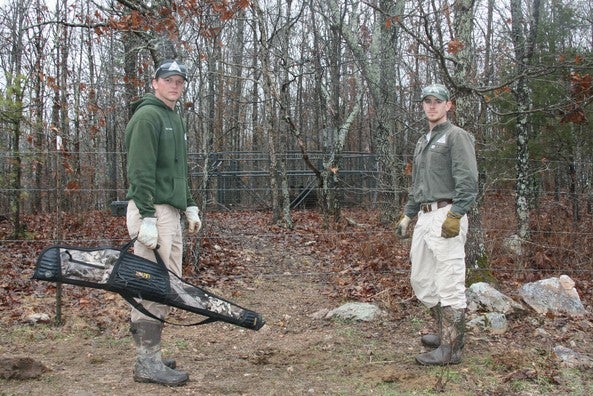
Xplor reconnects kids to nature and helps them find adventure in their own backyard. Free to residents of Missouri.


































Stay in Touch with MDC news, newsletters, events, and manage your subscription

Xplor reconnects kids to nature and helps them find adventure in their own backyard. Free to residents of Missouri.

A monthly publication about conservation in Missouri. Started in 1938, the printed magazine is free to residents of Missouri.




PIEDMONT, Mo. -- It’s muddy, slippery and slimy. It’s a feral hog trapping scene, where 14 feral hogs rooted up all vegetation, leaving a mud pit in the middle of an otherwise pristine wooded area. Missouri Department of Conservation (MDC) employees Matthew Peter, a wildlife biologist assistant, and Ethan Roach, a wildlife technician, walked through the rain with their gear to approach a trap full of feral hogs. After dispatching the hogs, they slosh through the mud and push with all their might to reposition the large steel trap that’d been moved several inches by the lunges of a boar in a display of power.
The two removed the heavy hogs from the trap and set it again for the next group of feral hogs after repairing the damage the last sounder did to the trap.
“These big boars are strong, they move these traps all the time,” Peter said as he used a tree to leverage his weight against the trap.
The boar had pushed the large trap into a tree, blocking the crank to open the trap. It took every bit of Peter and Roach’s strength, along with help from a supervisor, to push the corral trap far enough to have access to the crank again. This is just part of trapping feral hogs, something dealt with on a regular basis, but not something people usually hear about. The work of a feral hog trapper requires grit to endure working in the elements and problem-solving abilities to overcome things that come up, like a steel trap that’s been pushed up against a tree by a boar.
“We don’t always have someone to help,” Peter said. “A lot of times we’re out at a site by ourselves and just figure out how to make it work.”
Peter coordinates feral hog trapping efforts in MDC’s southeast region. He starts each work day around 7 a.m., checking traps before going to meet with cooperating landowners. He rounds out his day by completing public lands management duties unrelated to feral hogs. MDC has eight regional feral hog trapping teams ranging from two to 40 staff members, depending on how prolific feral hogs are in that region. In some regions, like the southeast, many MDC employees, from foresters to conservation agents are spending hours each week on feral hog elimination efforts, in addition to their other job duties.
Feral hogs are highly destructive and prolific pests that will eat nearly anything, including many species of native wildlife. They compete directly with native wildlife by eating acorns, a major fall food source for deer, turkey, and black bear. Their rooting and wallowing behaviors destroy Missouri’s landscape and pollute waters. A group of ten hogs can destroy 20 to 30 acres overnight, including crops, causing financial burdens on Missouri’s landowners and agriculture producers. Damage caused by hogs has been estimated at nearly $1.5 billion per year in the United States.
Peter and Roach are efficient, coordinating feral hog trapping efforts in five counties, assisting more than 250 landowners a year. They schedule trapping efforts weeks in advance and group landowner visits together if the landowners are fairly close to each other.
“Grouping landowner visits helps people see that they’re working together with their neighbors and how important that is,” Peter said. “It helps people to realize why we remove whole sounders at once. If we picked off just one or two feral hogs at a time, the remaining will go visit the neighbor and then come back later. Neighbors have to work together to remove all the feral hogs.”
Although Peter said most wildlife biologists begin conservation careers with a dream of working in beautiful landscapes, it’s the desire to preserve those landscapes that makes working in muddy feral hog pits rewarding.
“Sure, I’d prefer to spend every day managing different Ozark habitats, but if we neglect this feral hog problem all the habitat work will likely be destroyed by these destructive pests,” he said. “Rain or shine, we’re likely checking feral hog traps or meeting with landowners.”
In fact, the cold and rainy days can persuade feral hogs to seek out more food, which means it’s best to try to use the unpleasant weather as much as possible. Feral hogs tend to react differently to the environment during each season, he said. During the warmer parts of the year they favor shaded locations close to water, while during the late winter they prefer hillsides or drainages that shelter them from harsh weather. Knowing what feral hogs need and relating this to what the environment provides in certain seasons, helps feral hog trappers to predict their movements and be successful.
“MDC has always battled invasive and non-native species that threaten our native plants and wildlife,” Peter said. “Feral hogs may well be the worst of those, so I’m not really surprised that I’m spending a large part of my career working against feral hogs.”
Peter said although the work is challenging, it’s rewarding.
“When we save someone’s crops and hay fields, wildlife habitat or someone’s yard, that’s rewarding,” he said. “Removing a destructive group of feral hogs from a Missouri glade or woodland is what I’m here for.”
MDC and its partners have removed 2,466 feral hogs from Missouri’s landscape in 2018. To learn more about feral hog trapping efforts in Missouri, or to report feral hog sightings, go online to mdc.mo.gov/feralhogs.